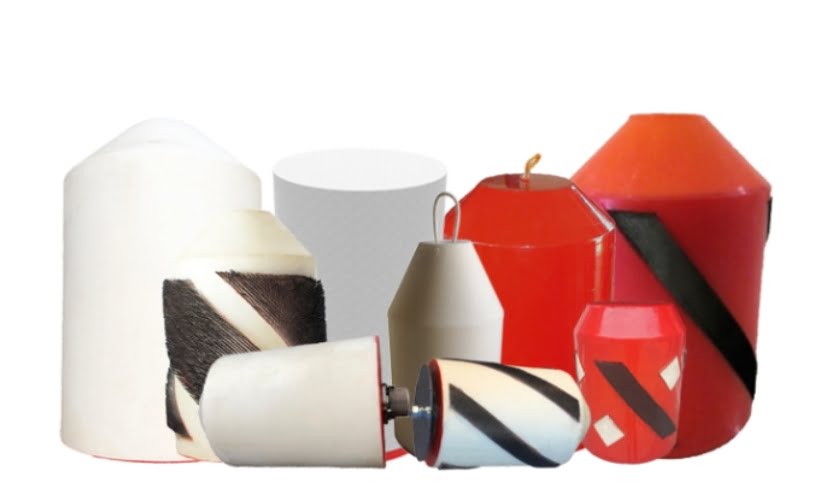Description
Introduction
Polly Pigs are a type of pipeline pig used extensively within the pipeline industry for various maintenance and operational tasks. Named for their polyurethane construction, Polly Pigs are designed to traverse pipelines for functions such as cleaning, inspecting for damage, and separating different products within the pipeline. They are often cylindrical and feature a variety of configurations, including bare, coated with a wire brush, or equipped with abrasive straps, depending on their specific application. Their flexible and robust design makes them suitable for pipelines of various diameters and conditions. As a result, Polly Pigs have become an essential tool in maintaining the efficiency, safety, and longevity of pipeline systems globally.
Detailed Description of Polly Pigs
Characteristics of Polly Pigs: Sizes, Materials, and Variability
Polly Pigs, named for their primary construction material, polyurethane, is a specific type of pipeline pig used extensively in various pipeline operations. They come in a variety of sizes to accommodate different pipeline diameters, ranging from small to quite large, and their colors may vary based on the manufacturer or the specific application for which they’re designed. The density of the polyurethane used in their construction can also vary, with higher-density pigs used in applications requiring more robust cleaning or where a greater sealing capability is needed.
Unique Versatility and Adaptability of Polly Pigs in Pipeline Operations
One of the unique features of Polly Pigs is their versatility. They can be simple and smooth for light cleaning and drying tasks, or they can be equipped with additional components like wire brushes or abrasive straps for more intensive cleaning requirements. They are flexible and can navigate bends and changes in pipeline diameter more easily than some other types of pigs.
Comparative Analysis: Polly Pigs vs. Skeletal Cleaning Pigs
In contrast, skeletal cleaning pigs, another common type of pipeline pig, often have a steel body frame and are equipped with replaceable brushes or scrapers. They are often used for more heavy-duty cleaning tasks where significant deposits need to be removed from the pipeline walls. However, due to their steel construction, they may not be as flexible as Polly Pigs and could be less suitable for pipelines with tight bends or significant changes in diameter. The choice between Polly Pigs and skeletal cleaning pigs generally depends on the specific requirements of the pipeline operation.
Polyurethane, the primary material used in the construction of Polly Pigs, is chosen for several reasons:
1. Durability: Polyurethane is a robust material that can withstand harsh conditions inside pipelines, including high pressures, varying temperatures, and corrosive substances. It is resistant to wear and tear, ensuring the pig can complete its journey through the pipeline without breaking apart.
2. Flexibility: Polyurethane is a flexible material, which is crucial for a device that must navigate through pipelines with varying diameters, bends, and turns. This flexibility allows the pig to maintain contact with the pipeline walls for effective cleaning, inspection, or separation tasks.
3. Versatility: Different densities of polyurethane can be used to create pigs with varying degrees of hardness. This allows for a range of applications, from soft pigs used for light cleaning or drying, to harder pigs used for more aggressive cleaning or scraping tasks.
4. Cost-effectiveness: Polyurethane is a relatively inexpensive material, making it a cost-effective choice for creating disposable pigs that are not retrieved after use.
These characteristics make polyurethane an excellent material for pipeline pigs, offering a balance of durability, flexibility, versatility, and cost-effectiveness.
Basic Parameters
| Name | Polly Foam Pig |
| Performance | 1. Its interior is foamed by polyurethane material. The surface is coated with a polyurethane elastomer coating. |
| 2. It has good flexibility and certain wear resistance. | |
| 3. The deformation amount can reach 50%, which is the most widely used foam pig. | |
| 4. It is used for scrubbing, descaling, and fluid isolation of pipes. | |
| Technical Parameters | Staring pressure: 0.02MPa |
| Density: 35kg/m³-220kg/m³ | |
| With Pressure: 7MPa | |
| Compression ratio: 50 | |
| Attrition rate: 2mm/100km | |
| Operating temperature: -30℃ to +100℃ | |
| Stretch rate: 320% | |
| Flex life: 50,000 times | |
| Operating distance: 100km-300km |
Applications of Polly Pigs
1. Cleaning:
Polly Pigs are widely used in the pipeline industry for cleaning purposes. They are inserted into the pipeline and propelled by the product flow or by a separate medium like water or air, depending on the pipeline’s contents and the operation’s requirements. As the Polly Pig moves through the pipeline, it scrapes off any accumulated deposits or debris on the pipeline walls, effectively cleaning the interior surfaces. Different Polly Pigs can be utilized for various degrees of cleaning. For instance, a Polly Pig equipped with abrasive straps or wire brushes can provide a more aggressive cleaning action to remove tougher build-ups.
2. Inspection:
While Polly Pigs themselves are not typically equipped with inspection equipment, they play a crucial role in inspection procedures. Prior to an in-line inspection (ILI) using an intelligent pig equipped with sensors and data collection devices, a Polly Pig is often used to clean the pipeline. This is to ensure that any accumulated debris or deposits do not interfere with the inspection process, enabling the intelligent pig to accurately detect and record any anomalies, such as corrosion, cracks, or dents within the pipeline.
3. Separation:
Polly Pigs are also used to separate different products within a pipeline. In multiproduct pipelines, it’s necessary to minimize the mixing of different substances to maintain product quality. A Polly Pig can be inserted between two different products to act as a physical barrier, effectively reducing product mixing during the transition. The pig’s flexibility and sealing characteristics ensure a good fit within the pipeline, minimizing bypass and thereby maximizing the effectiveness of the separation.









Reviews
There are no reviews yet.